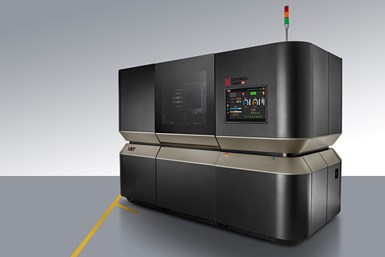XJet’s NanoParticle Jetting (NPJ) Produces Ceramic, Metal Parts
Formnext 2022: XJet’s portfolio of metal and ceramic AM solutions is powered by NanoParticle Jetting (NPJ) powderless technology to produce excellent part quality, surface, accuracy and detail with no postmachining.
XJet’s technology focuses on helping manufacturers achieve automated, environmentally-friendly and scalable additive production of high-definition metal and ceramic parts. The Carmel 1400 solution uses NanoParticle Jetting (NPJ) powderless technology, to achieve parts of native quality and design complexity, solving industry challenges in multiple industries. The Carmel 1400M is for metals and Carmel 1400C is for ceramics.
The company says three green and automated steps — from file to final part production in metal and ceramic manufacturing — can set new standards in the growing metal AM market.
XJet will join with Azoth, one of its metal system users, at its Formnext booth to share the team’s practical experience and knowledge of working with XJet’s metal AM solution. “We’re seeing high demand for XJet capabilities,” says Cody Cochran, Azoth general manager and co-founder. “Fine features, high resolution and good surface finish, right off the printer, which perfectly complements our expertise in metal manufacturing. The Carmel 1400M system allows us to go from small-volume to full-scale manufacturing on the same system, without having to adapt the equipment in the transition to manufacturing.”
The Carmel 1400M additive manufacturing system is designed to offer excellent part quality, surface, accuracy and detail with no postmachining, as well as superior capability for producing complex parts. The company will have the system running live on stand C01all 12.0 at Formnext, alongside its Smart Station for automated soluble support removal.
“As crowded as the metal AM sector is, XJet technology has something truly unique to offer the market,” says Yair Alcobi, XJet CEO. “Sharp angles, overhangs, internal cavities are still often difficult to achieve with other technologies, but because of our unique soluble support material and automated support removal with the Smart Station, these features are no problem for XJet and can be produced repeatedly, reliably and on an industrial scale. Our unique use of material jetting and nanoparticles means we get significantly finer detail, improved surface finish and thinner walls than any other metal or ceramic AM technologies.”
It is said using nanoparticles and substantially less binder in its process enables XJet to achieve superior material density and lower sintering temperatures by around 15% for stainless steel, saving energy and subsequently seeing less shrinkage and deformations as the process moves away from the melting point of the metal. In addition, using sealed cartridges for materials makes the Carmel 1400M easy to operate and safe to use.
At Formnext, XJet will also display the next developments in its range of materials, which currently includes 316L stainless steel and, in its ceramic range, zirconia and alumina.
Related Content
-
Lithoz CeraFab System S320 LCM Printer Designed for Efficient, High-Capacity Industrial Serial Production
Formnext 2024: The system offers a build speed of up to 150 layers per hour and layer thickness of 20–200 µm.
-
Italian Furniture Maker Uses WASP Technology to Create 3D Printed Pendant Lamps
The versatility of 3D printed ceramic enabled the designers to shape a weave reminiscent of the beehive concept, enhanced by the light source.
-
MoldJet Technology Enables High-Throughput Metal, Ceramic Additive Manufacturing
Formnext 2023: Tritone Technologies’ additive manufacturing solutions enable industrial throughput of accurate parts with a range of metal and ceramic materials.















